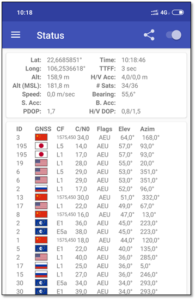By Sean Barbeau*.
As the developer behind GPSTest, a popular open-source Global Navigation Satellite System (GNSS) testing app for Android, it’s been incredible to see the advances in both device and satellite technology over the last five years.
I’ve learned a lot along the way, and there have been many surprises in terms of how embedded GNSS behaves on Android devices. However, the most surprising revelation by far has been related to EU’s Galileo.
Galileo in the United States
European users began to see Galileo satellites as early as October 2016, before Galileo had even officially begun operating.
I hoped to see Galileo satellites on my own device in the U.S. at the time, but no such luck. Initially, I chalked this up to Galileo not yet officially being in-service.
Then, Galileo started offering Early Operational Capability (EOC) on December 15, 2016 . Like many users around the world, I opened the app on my phone hoping to see new satellites, but still no Galileo.
At this point, I assumed that the lack of Galileo satellites was due to regional device variants. In the U.S. we get devices that are different from international versions, for a variety of reasons. At the time there wasn’t a publicly available list of Galileo-compatible devices, so I assumed that my device wasn’t compatible with Galileo.
But then a user posted a very interesting experience while flying from Europe to U.S. with GPSTest running on their phone. While in Europe, the user was able to see Galileo satellites. As soon as he crossed into U.S. territory, Galileo satellites disappeared.
Currently Galileo coverage is nearly global with only a few gaps. And, as of October 2018, there are 18 operational Galileo satellites. So satellite coverage isn’t the issue.
The case remained a mystery until the same user that did the cross-Atlantic experiment unearthed some really interesting documents which broke the case wide open.
Mystery solved
Users in the U.S. can’t see Galileo satellites in GPSTest, but it’s not due to any device or satellite technology limitation — it’s due to a Federal Communication Commission (FCC) regulatory restriction.
United States Electronic Code of Federal Regulations (eCFR) Title 47 › Chapter I › Subchapter B (pause, take a deep breath) › Part 25 › Subpart B › Section 25.131 › (j) says:
Receive-only earth stations operating with non-U.S. licensed space stations shall file an FCC Form 312 requesting a license or modification to operate such station.
Mobile devices are apparently considered “receive-only earth stations,” and Galileo satellites are “non-U.S. licensed space stations.” Therefore, the EU must request a license to operate such stations in the United States or request a waiver to be exempt from this policy before Galileo can be used in the U.S.
Apparently, the U.S. National Telecommunications and Information Administration (NTIA) started the exemption waiver request process for the European Commission (EC) on behalf of the EU in 2006, with the EC officially applying for the waiver in 2013. Some of this history is documented within the FCC’s request for public comments on the EC application, dated January 6, 2017. The request-for-comments document says:
In its letter recommending grant of a waiver, NTIA notes that the National Space Policy of the United States of America specifically directs the United States to “engage with foreign [Global Navigation Satellite System (GNSS)] providers to encourage compatibility and interoperability, promote transparency in civil service provision, and enable market access for U.S. industry.” In addition, it notes that [Galileo] may…augment and strengthen the resiliency of the Global Positioning System (GPS)…and bring significant benefits to the American public.
Many organizations have submitted letters of support for the Galileo waiver request in response to the request-for-comments.
GNSS hardware manufacturer Broadcom said:
Broadcom strongly believes that a combined GPS + Galileo system will outperform a GPS-only system while not suffering any degradation as a result of the addition of Galileo in receiver designs. The improvement provided by the addition of Galileo is extremely inexpensive to the consumer and has no effect on the level of protection of the GNSS receivers against adjacent or nearby operations.
Broadcom is unaware of any technical concerns that would bar the grant of an FCC waiver for use of Galileo signals and based on the potential benefits, strongly urges the FCC to grant such a waiver.
Qualcomm, which manufactures chipsets for mobile devices that include positioning solutions, also responded in support:
The use of additional positioning, navigation and timing (“PNT”) satellite systems, such as the Galileo system, can improve the reliability, availability, and resiliency of PNT services in the U.S. Qualcomm agrees that the integration of additional satellite systems can enhance countless services and applications in the U.S. that rely upon accurate PNT data.
The non-profit National Emergency Number Association (NENA), a professional organization for the public safety community which advocates for improved emergency communications via 911, said:
In NENA’s view there are three clear benefits to approving the waiver. First, approving the EC’s waiver request will improve the availability and reliability of alternative (non-NavStar/GPS) GNSS signals, particularly in challenging environments. Second, it will improve system performance for both caller location and call routing. Third, it will reduce geopolitical uncertainty as to the accuracy, integrity, and availability of the overall 9–1–1 positioning technology suite… Such an action is clearly in the interest of the public and the public safety community by which the public is served.
T-Mobile, a U.S. cellular carrier, went even further to say:
The Commission should allow U.S. devices to receive Galileo signals. It also agrees with commenting parties that the current process for permitting devices to receive non-U.S. GNSS signals is unnecessarily complex and lengthy. The better approach to providing the requested relief for mobile wireless user devices is for the Commission to declare that they are not covered by Section 25.131(j) at all.
The only negative comments I’ve seen are from companies Trimble, Inmarsat, and Ligado. Trimble complained that the free Galileo High Accuracy service could undercut their own paid commercial services, but ultimately still supported the Galileo waiver. Inmarsat initially raised potential interference issues with their own satellites, but they have agreed to a testing plan with the EC that would resolve any potential interference issues. Ligado, formerly Lightsquared, raised concerns about potential Galileo interference with it’s own spectrum. Ligado continues to pursue Lightsquared’s plan of re-purposing satellite spectrum for ground-based telecommunications (to the tune of $3.6 million in lobbying over the last three years), although these efforts have been blocked by the government due to interference with GPS. So, it’s a bit ironic that Ligado is complaining that Galileo could interfere with it’s own future network.
It seems pressure is building on the FCC to approve the waiver. On August 6th, the National Space-Based Positioning, Navigation, and Timing Advisory Board recognized the importance of this issue in their meeting and recommended the following actions:
- Civil users in the U.S. should be allowed to legally access without an individual license and use non-U.S. GNSS signals
- The Administration should consider revisions to current policy guidance and an integrated governance framework that addresses current fragmentation of resources and accountability
Meanwhile, Glonass
Here’s the really strange part of this whole situation. As of October 2018, I can still see Russian GLONASS satellites in use on my mobile device in Tampa.
So, take a minute to absorb this. If you’re located within the U.S., your phone is using signals from Russian GLONASS satellites to compute it’s position. At the same time, it’s throwing away signals from EU Galileo satellites because the FCC hasn’t approved the EC’s waiver application.
Why? I can only speculate, but I’m guessing Russia didn’t know about or ignored the waiver process, as did the manufacturers rolling out devices that supported GLONASS. The PNT Advisory Board presentation referenced earlier seems to imply this, saying:
Cell phone and satellite navigation receiver manufacturers have incorporated non-U.S. GNSS within their equipment. Yet FCC rules require any non-federal receiver in the U.S. using non-U.S. signals to be licensed. None of the millions of receivers in the U.S. have yet been licensed.
Surprise! In your pocket you have an unlicensed device receiving satellite signals from a foreign government against federal regulations.
Conclusions
Thankfully, the Galileo saga appears to be coming to a close. On October 24th, FCC Chairman Ajit Pai announced that the Commission will vote in November (presumably in their November 15th open meeting) on allowing American devices to use signals from Galileo. Given the positive tone of the announcement, it seems that Galileo may be headed for official approval.
So when will your device in the U.S. show Galileo satellites? Great question. Give GPSTest a run on your device and let me know what you see in the comments below.
There is still one open question — what about Chinese GNSS Beidou? In the experiment I mentioned earlier, Beidou satellites were also visible on the device until the user entered U.S. territory. To my knowledge, China hasn’t submitted a waiver request, and from the announcement it doesn’t sound like the FCC is debating the larger issue of whether embedded GNSS in mobile devices should be exempt from the Section 25.131(j) rule. So let me know if you see any Beidou satellites too! Happy hunting!
*Sean Barbeau, GPSTest app developer (Original article at Medium).
Dear reader, would you like to have your article pubilshed in our website? Send us your document to info at galileognss dot eu, and we’ll be pleased to do so.



I had wondered when I’d get Galileo satellites on my phone, and your explanation makes a lot of sense. Thanks for peeling back the curtain a little.
Are you sure about this? We’ve been using Galileo and BeiDou satellites in the US for a long time. There’s no magic filter in receivers at which Galileo or BeiDou stops working over North America.
I ‘ve been in USA last july, and my Moto x4 (Oreo 8.0, APP GPSTest (barbeauDev) ) did not show any galileo sat´s at all, back in Germany it is receiving Galileo signals….may be it depents on the device manufactors GPS Firmware??
The only gnss systems seen using a OnePlus 6 in the USA are GPS and GLONASS. Same phone in Europe also sees BDS and Galileo. Apparently geofencing is used. Some phones don’t use geofencing but use foreign chipsets and firmware